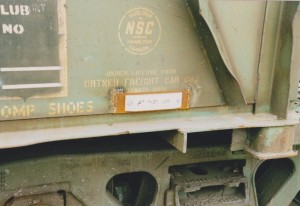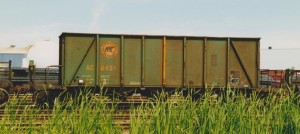These big, forest-green 100-ton capacity rapid discharge hoppers were a distinctive sight on the Algoma Central; and at a total of 300 cars built to this design in 1974-75, formed the largest part of the Algoma Central’s hopper fleet during the 1980s. These cars replaced aging 55 to 70-ton twin hoppers that had build dates ranging around World War I.

Builder’s stencil on AC 8422. Blair Smith photo.
These 300 cars were built by National Steel Car of Hamilton, ON using a design licensed from Ortner Freight Car Co. of Cincinatti, OH. The cars were built and delivered in two batches:

AC 8376. Blair Smith photo.
AC 8201-8400 built from January into April of 1974.

AC 8451. Blair Smith photo.
AC 8401-8500 built from January to February of 1975.
Both series are visually identical except that the middle rib on all of the cars in the second batch was painted yellow. The significance of this is a little vague; it certainly did not indicate an assigned service, as all of the Algoma Central’s hopper cars mixed together freely, and the only hopper traffic the ACR handled was all related to the iron ore processing plant at Wawa (including hauling limestone, coke and other ore fines from the harbour at Michipicoten to Wawa), and shipping this output south to the Algoma Steel mill at Sault Ste. Marie.

Stock Walthers “Platinum Line” Ortner hopper in AC lettering.
Fortunately, Walthers has produced a model of the Ortner design that NSC licensed, so modelling these cars is relatively straightforward, although there are some minor differences between the NSC and Ortner versions. (Of course.) Many of these are pretty minor, and most modelers may choose to ignore them, but I wanted to capture some of the signature flavour of these NSC clones. Also, as Walthers has these cars available in AC paint and lettering, some may wish to avoid repainting as much of the car as possible. (Unfortunately however there are some errors and deficiencies in the Walthers lettering; I’ll go over these in more detail when I discuss painting and lettering the models, but for now I will just mention that a decal set is available from Black Cat Decals that can be used to correct the lettering or fully repaint and re-letter the Walthers car.)
The main difference between the AC prototypes and the Walthers model is the most visible, and this is one that any serious AC modeler will really want to change. The Walthers model comes with a pair of solid bulkheads dividing the car into three separate bays, while the prototype cars were fully open like most standard hoppers with V-shaped tubular structural bracing in between the bays.
Other minor differences involve the handrails and the top cap of the end of the cars; this will be discussed in detail when I discuss how I model these changes in upcoming posts in this series.
That’s about it for the intro; coming up – modifying the interior of the cars.





